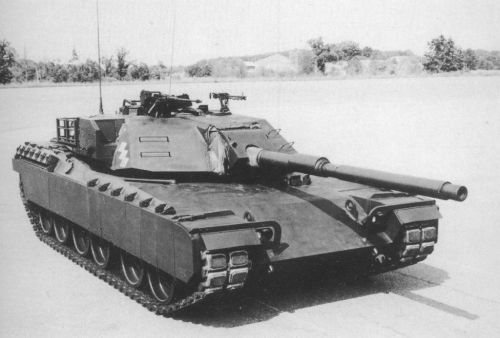General Motors XM1 prototype
Congress canceled the MBT-70 in November and XM803 December 1971, and redistributed the funds to the new XM815, later renamed the XM1 Abrams after General Creighton Abrams. Prototypes were delivered in 1976 by Chrysler Defense and General Motors armed with the license-built version of the 105 mm Royal Ordnance L7 gun along with a Leopard 2 for comparison.
The actual development of the XM-1 was carried out on a competitive basis, contracts for it being awarded in 1973 to Chrysler and to General Motors. Both companies completed their prototypes in 1975 and after trials the Chrysler XM-1 was chosen in 1976 for further development on the grounds that it was being offered at a lower cost. The principal engineering difference between the two was that the General Motors prototype was powered by a variable compression ratio diesel, which was not entirely successful, while the Chrysler prototype was powered by a gas turbine, which was expensive to produce and which, in spite of repeated claims to the contrary, proved to have a high fuel consumption. A conventional diesel would have been a better choice for either of the two designs and one of 1500hp had been developed in Germany for the MBT-70 but it was not considered for the XM-1.
Whichever of the two US prototypes won, it was intended that it should be evaluated in competition with the German Leopard 2 with the view of achieving standardization between the US and German tank fleets, ostensibly even to the extent of adopting the same tank for both. In the event all that happened was that the US Army decided in 1978 to adopt the 120mm smooth-bore gun produced in Germany for the Leopard 2. The decision was taken after trials carried out in 1977 when the German 120mm smooth-bore gun was compared with the US 105mm tank gun, which by then was 18 years old, and a new 120mm rifled gun hastily developed in Britain to suit US requirements.
#
In the late 1970s, two companies, Chrysler and General Motors, had competing prototypes of the M-1. General Motors had a large and traditional diesel engine in the tank, and Chrysler, which had tried and failed to develop turbine engine technology for cars and trucks for the commercial market, wanted to recoup their costs and put a risky and complicated turbine engine in their tank. The Army was ready to give the contract to General Motors, but politics intervened. In 1987, the Washington Monthly laid out the scene around the all-important decision of what tank was to be chosen:
On a July afternoon ten years ago, Lt. Colonel George Mohrmann sat at his desk on Capital Hill awaiting a phone call. As head of the Army’s congressional liaison office, he was ready to deliver a stack of sealed letters to members of Congress announcing the winning contractor in the multi-billion dollar competition to build the Army’s M-1 tank.
The two competing contractors, Chrysler and General Motors, offered a clear choice. Chrysler had built its tank around a radically different and unproven tank engine, the turbine; GM had used a more conventional diesel engine. The two tanks had undergone months of head-to-head trials at Aberdeen Proving Ground in Maryland.
GM had won.
The Army, it seemed, was not going to risk adding the M-1 to its growing list of overly sophisticated weapons that cost too much and don’t work. “We were sitting there poised to deliver [the envelopes],” Mohrmann recalls. “The decision [to select GM] had been made. We were just waiting for the Secretary of Defense to be briefed.”
The call, however, was surprising. The Pentagon told Mohrmann not to deliver the letters. The next day, Defense Secretary Donald Rumsfeld ordered a whole new round of competition. A week later, Rumsfeld turned the M-1 tank program upside down. He mandated that the tank be redesigned to incorporate the turbine engine. Four months later the award-which promised to generate $20 billion in sales – went to Chrysler and the Army was on its way to getting a weapon suited more for a paved interstate than a battlefield.
… That isn’t another story about the Army’s incompetent bureaucracy. “You can blame the Army for a lot of things,” says Anthony Battista, a staff member of the House Armed Services Committee, “but not for the troubles of the M-1.” Rather, it’s a story of how outside factors can overwhelm military considerations in the Pentagon decision-making process, how narrow interests – in this case the ailing Chrysler Corporation and, by a strange twist, the U.S. Air Force – can outweigh the need for a reasonably-priced and effective military. The M-1 was never just a weapon; it was also a bail-out package.
